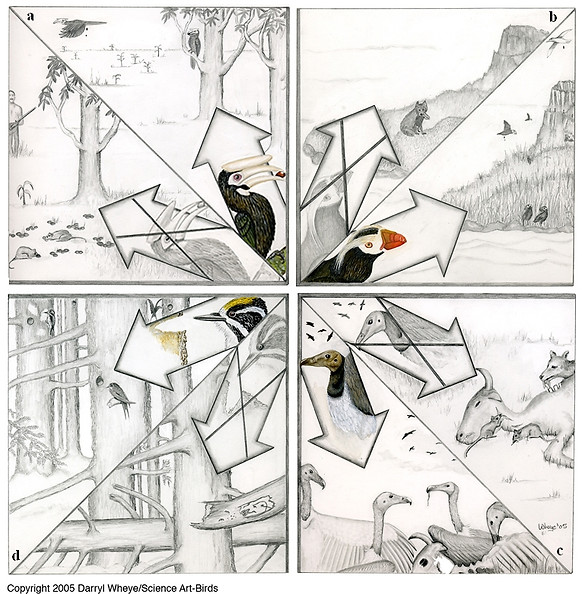*


*
Birds, butterflies,
and forest patches
ink and color charcoal
1993
in Birding for Fun, a
column by Paul Ehrlich,
in American Birds,
1993, vol. 47, no. 5, pp.1044-1046.
(American Birds was
the quarterly scientific journal of the National Audubon Society.
I illustrated the column from 1989 – 1994.
Science Art in
books
exhibits
installations
magazines
and journals
virtual exhibits
on the web
available
other
(above) A charaxia butterfly (Archaeoprepona demophon,) and the Bicolored Antbird (Gymnopithys leucaspis) inhabit tropical moist forests and avoid forest edges,while a sulphur butterfly (Phoebis argante) and the Violet Sabrewing hummingbird (Campylopterus hemileucurus) frequent disturbed edge habitats.
(left) In recent years, populations of such neotropical migrants as (clockwise from the top left) Prairie Warbler, Whimbrel, Blue-winged Teal, American Kestrel, and Scarlet Tanager have declined dramatically and, in the process, have beome ambassadors for cooperative international conservation efforts.
Barn Owl
ink, colored charcoal and pencil
2000
in Kennedy, D. 2001 Everything but
the cardinal, in Stanford Magazine,
March/ April, pp.60-65.
*
Artwork is available
Contact: darrylwheye@gmail.com

scroll
*

*

Cover art for Birding magazine:
left: Avostilt
watercolor
2005
The Avostilt (front) is a hybrid of a Black-necked Stilt (Himantopus mexicanus) (rear), and an American Avocet (Recurvirostra americana) (middle)
and
right: Ivory-billed Woodpeckers
pencil
2007
Ivory-billed Woodpeckers (Campephilus principalis) return to their nest, ruined in a violent storm (the imagined last nesting effort of the presumed extinct species).
For more, see coverage from the magazine.
Giclee print of cover art (17 x 30") $400
Avian Ecosystem Service Providers
ink and colored charcoal
2004
in Sekercioglu, C.H. 2006. Increasing awareness of avian ecological function TRENDS in Ecology and Evolution, June, Vol.21 No.8 pp. 464-471
"Figure 1. Examples of the four main types of avian mobile links [1] and the potential consequences of their removal.
(a) Genetic linkers (: in the Philippines, the loss of seed dispersers, such as Palawan hornbills Anthracoceros marchei, can result in most seeds being deposited under the parent tree and being consumed by seed predators.
(b) Resource linkers: the elimination of Aleutian seabirds, such as tufted puffins Fratercula cirrhata, by introduced foxes can lead to reduced nutrient deposition, triggering a shift from grassland to maritime tundra.
(c) Trophic process linkers: disappearance of scavenging Indian long-billed vultures Gyps indicus, can cause increases in the number of rotting carcasses and of attending mammalian scavengers.
(d) Trophic and non-trophic process linkers: reduced numbers of three-toed woodpeckers Picoides tridactylus in forest fragments can cause increases in spruce bark beetles (Dendroctonus and Ips species) and decreases in nesting holes used by other species. In addition to habitat loss, which affects all avian functional groups, Large frugivores are highly susceptible to exploitation, seabirds are threatened by by-catch mortality and introduced species, woodpeckers decline as a result of fragmentation and vultures are particularly sensitive to chemicals."


*
*


*
Carved Figurehead on Maori War Canoe
pencil
© 2007 based on Haddon and Hornell, 1936-38
IN Rogers, D.S. and P.R. Ehrlich. 2008. Is a science of cultural evolution possible? Testing cultural rates of change in Polynesia.
Proceedings of the National Academy of Sciences, Mar 2008, 105 (9) 3416-3420; DOI: 10.1073/pnas.0711802105
Figure 2. Symbolic traits for Polynesian canoes presumably have no differential effect on survival from group to group.
A. Painted paddle from Rapanui (Easter Island), alongside face tattoo from the Marquesas.
B. Canoe from Manihiki decorated with inlaid shell.
C. Carved figurehead on Maori war canoe (New Zealand).

*

Ventral Larval Band
composite: drawing with photographic overlay of modified larval band
2015
Shows how coloration can resemble a caterpillar's segments and how those segments seem to align with the veins in the wing, especially on the ventral (underside) of the hind wing.
Monarch II
pencil
2015
Arrow shows how placing a caterpillar on the the wing edge, the wing edges resemble a caterpillar.

